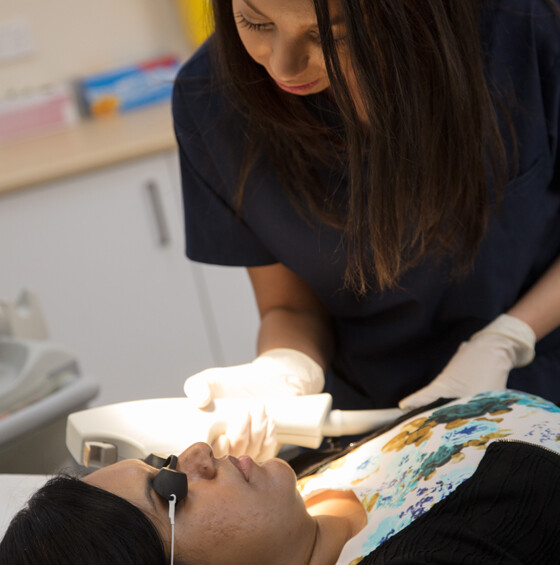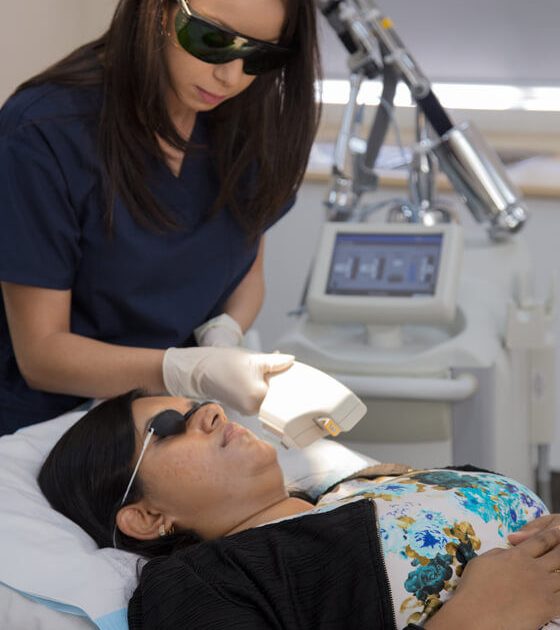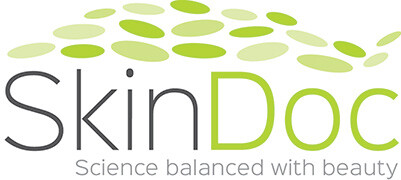Intense Pulse Light Devices (IPL)
IPL devices are polychromatic, noncoherent light that uses cut-off filters to narrow the wavelength to target specific structures in the skin. The pulse duration, interval between pulses and the energy (joules) can be varied to selectively target vascular, pigmented lesions, acne, hair reduction etc.
IPL has been used to treat atrophic as well as hypertrophic scars.
IPL
IPL stands for intense pulse light. These are devices that use flashlamps and band filters to produce pulsed polychromatic high intensity broadband light. The emission spectrum of IPL sources range from the visible to near-infrared range (400-1200nm). The pulse duration and intervals between pulses vary widely between devices. The basic principle of Intense Pulse Light devices is similar to laser devices which is selective photothermolysis. A major advantage of IPL devices is their ability to combine various wavelengths, fluences, pulse durations and pulse intervals which can be used to treat a wide spectrum of skin conditions. The ability to target haemoglobin, melanin and water using the same light exposure allows for several components of skin to be treated simultaneously.

IPL for Pigmented Lesions
IPL is effective in the treatment of melanocytic hyperpigmentation. Using a wavelength filter cutoff of 630nm it will filter out wavelengths below 630nm. Wavelengths between 630 nm and 1100nm will preferentially absorb melanin over haemoglobin. IPL can be used to treat solar lentigines effectively. Melanosomes have been shown to migrate from the epidermal basal layer towards the surface after therapy. With the addition of hydroquinone after IPL the activity of melanosomes can be effectively suppressed and eventually eliminated from the epidermis during normal desquamation.
IPL is best considered for high contrast lesions where the pigment difference between the background skin and the lesion is large. IPL have pulse durations in the millisecond range and therefore are ineffective in low contrast pigmented lesions. The latter are best treated with laser using Q-switched devices and are in the nanosecond range. The longer pulse of IPL as compared to laser decreases the risk of post-inflammatory hyperpigmentation due to the more gentle heating of the skin.
Treatment of moles with IPL or laser is controversial and is generally not recommended. Treatment with these devices can lead to residual melanocytes being left untreated in the deeper non-pigmented portion of the lesion. IPL and laser may cause superficial scarring which could potentially mask an underlying malignant process. The effect of IPL or laser on the transformation of a benign mole to a malignant melanoma is unknown. Benign moles and dysplastic moles are best treated with standard surgical excision.
The technique has been shown to have only moderate improvement with chloasma. Epidermal chloasma responds better than dermal chloasma. The treatment can potentially lead to worsening of the chloasma and recurrences are common after treatment.
IPL and Rosacea
IPL had been shown to effective in the treatment of diffuse redness and spidery vessels in rosacea. Treatments are performed once a month for approximately 3 to 4 months. A further treatment at 6 months may be required to maintain the improvement. IPL is more effective in lighter skin types I, II and III for treatment of redness. It is less effective darker skin types such as skin type IV and higher.
IPL and Photorejuvenation
Sun damaged and aged skin is characterised by wrinkles, rhytides, pigmentary changes, telangiectasia and skin thinning. The light leads to contraction of collagen as the collagen fibres are heated by the high intensity light energy. This leads to tightening of the skin. Thermal stimulation of fibroblasts in the dermis occurs as a result of the higher wavelengths within the spectrum leading to increase synthesis of extracellular matrix proteins. Wave lenghths in 1200nm spectrum are absorbed by water in the dermis, activate the cytokines and the stimulate the production of new collagen I and III as well as new elastin.
Decolletage Area
Photoageing changes on the anterior neck, upper chest, and shoulders is called Poikiloderma of Civatte in dermatology. It is an important area to consider in rejuvenation of the skin as it can lead to sharp demarcation line if the face has undergone rejuvenation but not the neck and chest. The skin on the neck and chest have thinner epidermis and dermis with less pilosebaceous units compared to the face. As new epidermal cells regenerate from the pilosebaceous units following a rejuvenation procedure the recovery time can be longer than for the same procedure performed on the face.
Three to four treatments at 4 weekly intervals may be required to achieve a clearance of about 80%. In general three to five treatment sessions are necessary to achieve optimal results.
Often this area shows redness, pigmentation, dilated or spidery vessels and poor skin texture. IPL may be the modality of choice is this area as it can treat all four conditions simultaneously in the right patient.

IPL and Acne
Photodynamic therapy is used with 5% ALA (5-aminolevulinic acid) which leads to induction of endogenous porphyrin and protoporphyrin IX which is then absorbed and concentrated within sebaceous glands. The area of skin is then exposed to certain wavelengths of light using IPL which targets the major absorption bands for protoporphyrins which include 410nm, 504nm, 538nm, 576nm and 630nm. This leads to the formation of reactive oxygen species with an ensuing bactericidal effect on Propionibacterium acnes (P. acnes). IPL can also target blood vessels that supplies the sebaceous glands leading to their destruction. IPL using photodynamic therapy can target the P. acne, sebaceous glands and the blood vessels supplying the sebaceous glands leading to their destruction. IPL with ALA photodynamic therapy has been shown to be more effective than IPL on its own in the treatment of acne.
IPL and its uses
IPL has been shown to have a broad therapeutic range and the number of indications of use in dermatology is increasing. It has very few side effects making it a good treatment option for many skin conditions. As more dermatologists become more comfortable with their use, IPL will become more a standard evidence-based device used in dermatology.
A new exciting area that IPL is currently being used is in the area of improving surgical scars. The mechanism of action is thought to be in a reduction of blood vessel formation which leads to a thickened scar. Preliminary studies evaluating the efficacy of IPL in improving keloids and hypertrophic scars from acne, surgery, burns and trauma found a clinical improvement in 92.5% of patients and 31.2% of them had an excellent improvement.
IPL and Complications
In experienced hands the complication risk is very low. IPL technology requires a great deal of knowledge of device and parameter settings such as wavelength, pulse duration, pulse frequency and fluence. Furthermore knowledge about the condition being treated is of paramount importance. Dermatologists are the experts in the area of the dermatological condition being treated, the principles regarding selection of the appropriate device and parameter settings.
As IPL devices have become increasingly popular due aggressive advertising, an increasing number of treatments are performed by nonmedical professionals. This has resulted in a disproportionate increase in complication rates in procedures performed by non-medical personnel.
At present the use of IPL is unregulated in Australia. In USA the FDA is improving the regulation on who is able to use these devices. The national regulator is ARPANSA (Australian Radiation Protection and Nuclear Safety Agency) which regulates IPL and laser devices are slowly moving to establish regulations governing these devices. Only WA and Queensland have regulations governing lasers but not IPL at present. In some beauty clinics the non-medical personnel operating the device may have had only a few hours of training. In contracts, Dermatologists in Australia have completed 5-6 years of undergraduate medical studies at university, 5 to 10 years of general medical and surgical training as a junior doctor in a tertiary public hospital, a minimum of 5 years of dermatology specialist training in accredited teaching hospitals in Australia and have often done a higher degree a such as masters or PhD as well as done further clinical dermatology training at an overseas institution before or after completing their medical specialist dermatology training. As part of our continuing medical education dermatologists attend scientific conferences nationally and internationally. Cosmetic dermatologists also attend the Australasian Society of Cosmetic Dermatologists conferences (ASCD) held yearly. The ASCD members are all members of the Australasian College of Dermatologists, the peak body of specialist dermatologists in Australia.

